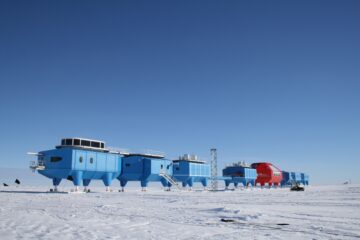Relocation of Halley Research Station
British Antarctic Survey is getting ready to move its Halley VI Research Station 23 km across the ice. This is the first time that the station, which has a re-locatable design to cope with life on a floating ice shelf, has been moved since it was towed from its construction site to its present location in 2012.
The station sits on Antarctica’s 150 m thick Brunt Ice Shelf. This floating ice shelf flows at a rate of 0.4 km per year west towards the sea where, at irregular intervals, it calves off as icebergs. Halley is crucial to studies into globally important issues such as the impact of an extreme space weather event (which could cause an economic loss of $6 – 42 billion a day), climate change, and atmospheric phenomena. It was scientific investigations from this location that led to the discovery of the Antarctic Ozone Hole in 1985.

Long-term monitoring of the natural changes that occur in the ice shelf has revealed glaciological changes, including new growth of a chasm that has been dormant for around 35 years. Preparatory work for the re-location was carried out during the 2015-16 Antarctic Summer season (Nov-March). Now that the station has emerged from months of winter darkness, operational teams are ready to tow the station to its new home. This involves uncoupling the 8 station modules and using large tractors to transport each module further inland. Scientific research at Halley will continue in temporary facilities at the existing site and move to the new location next season.
Tim Stockings is Director of Operations at British Antarctic Survey. He says:
“Halley was designed and engineered specifically to be re-located in response to changes in the ice. Over the last couple of years our operational teams have been meticulous in developing very detailed plans for the move and we are excited by the challenge. Antarctica can be a very hostile environment. Each summer season is very short – about 9 weeks. And because the ice and the weather are unpredictable we have to be flexible in our approach. We are especially keen to minimise the disruption to the science programmes. We have planned the move in stages – the science infrastructure that captures environmental data will remain in place while the stations modules move. ”

Issued by the Press Office at British Antarctic Survey.
Athena Dinar, Senior PR & Communications Manager, British Antarctic Survey, tel: +44 (0)1223 221 441; mobile: +44 (0)7909 008516; email: amdi@bas.ac.uk
About Halley science
- The Halley VI Research Station is an internationally important platform for global earth, atmospheric and space weather observation in a climate sensitive zone (Antarctica).
- In 2013 Halley VI attained the World Meteorological Organization (WMO) Global Atmosphere Watch (GAW) Global station status, becoming the 29th in the world and 3rd in Antarctica.
- Ozone measurements that have been made continuously at Halley since 1956 (which led to the discovery of the ozone hole), contribute to the WMO’s Earth Observation strategy for co-operation and integrated systems for monitoring of the atmosphere.
- Space weather data captured at Halley VI contributes to the Space Environment Impacts Expert Group that provides advice to Government on the impact of space weather on UK infrastructure and business. It is estimated that, if a severe space weather event occurred, the total daily economic loss of a severe space weather event ranges from $6-42 billion for the USA, with an additional indirect loss to the global economy of $1-7 billion. See: https://www.jbs.cam.ac.uk/fileadmin/user_upload/research/centres/risk/downloads/AIG_Helios_Solar_Storm_16_June.pdf
- An ongoing European Space Agency research experiment at Halley VI that focusses on preparation for prolonged space flight uses Antarctica (Halley VI and Concordia research stations) to test how people can adapt to life in remote and isolated locations. This project supports UK Government policy (2015) for the human exploration of space.
About the re-location project
- Halley Research Station is modular. Each module can be de-coupled from the others and towed across the ice by tractors
- In 2015/16 field season glaciologists and operational teams conducted a survey to identify a new site for Halley Research Station which is located 23 km upstream on the Brunt Ice Shelf.
- Operational teams have identified a safe route across the ice to the new site named Halley VI a.
- The relocation project will be carried out over three years. Work began in 2015-16 with in-depth site surveys, detailed ice monitoring and initial preparations to de-couple the modules.
- The focus for the 2016-17 season is establishing temporary camps for housing the workforce and starting to move some station infrastructure to the new site.
- Temporary facilities, including containerised accommodation units will support the relocation team.
About the Brunt ice shelf movement
- Ice shelf movement is unpredictable. Scientists use a range of different technologies to monitor the changes to chasms and other ice features.
- In 2012 satellite monitoring of the Brunt ice shelf revealed the first signs of movement in a chasm that had lain dormant for at least 35 years. Glaciologists classify very large cracks in the ice shelf which clearly go all the way through to the sea as “chasms”, and narrow cracks that go an indeterminate depth as crevasses or cracks.
- glaciologists monitored this movement closely to determine whether or not the chasm was likely to grow
- In 2015/16 field season glaciologists used ice penetrating radar technologies to ‘ground truth’ satellite images and calculated the most likely path and speed of the crack. Monitoring continues
- In October 2016 a new crack emerged some 17km to the north of the research station across the route sometimes used to resupply Halley. This route will not now be used as alternative relief sites are available. Glaciologists are monitoring routes closely.